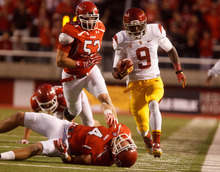This is an archived article that was published on sltrib.com in 2012, and information in the article may be outdated. It is provided only for personal research purposes and may not be reprinted.
On one play, it's Moe Lee getting confused in coverage. On another, it's Eric Rowe with a lapse, or Brian Blechen or Ryan Lacy failing to wrap up a receiver.
Halfway through the season, Utah's secondary has slipped into a troubling pattern. The corners and safeties play well for several downs, but then inevitably give up a big play that leads to a crucial first down or score for an opponent.
What gives? What has happened to Utah's sticky secondary coverage, which was so feared in the Mountain West?
After years of dominating the majority of opponents they've faced, Utah's back defenders are getting a reality check in their second year of Pac-12 play.
The receivers they now face on a weekly basis are better than anything they saw in the Mountain West. And the learning curve has been steep.
"It has been a challenge for us every week," Blechen said. "We are trying to be better and be consistent, but you have one slip-up and teams make you pay."
Utah's defenders are accustomed to playing a good receiver here or there, but in the Pac-12 they are facing teams that have two or more. USC came at them with the tandem of Robert Woods and Marqise Lee, UCLA had Shaquelle Evans and tight end Joseph Fauria, and Oregon State on Saturday will deliver Brandin Cooks and Markus Wheaton — who could be the best two wideouts the Utes will face all year.
Both are known for their speed as much as their catching skills.
If there is any comfort in the upcoming matchup, it is that the Utes' defense is improving, coaches say, particularly after moving Reggie Topps into a starting role at corner.
"I thought we held up OK against USC," Utah coach Kyle Whittingham said. "We gave up one ball over the top, but that was it. It was a good defense in the back end, and we need the same thing this week."
Cooks and Wheaton are averaging 131.8 and 112.8 yards a game, respectively. Keeping them corralled is crucial for the Utes to have a realistic shot at an upset against the No. 8 team in the country.
But they also are just the kind of players who the Utes have been susceptible to, particularly with their ability to turn a short pass into a big gain.
"Cooks is exceptionally fast, blazing speed," Whittingham said. "We have to have great technique with smart coverage. It's just like USC. You can't give all the attention to one, because the other will kill you."
Even with images of his guys getting burned by big plays still fresh in his mind, Utah cornerbacks coach Sharrieff Shah said he sees improvement.
"As a secondary coach, the things we've been harping on are starting to come without us saying it," he said. "The tendencies and coverages are becoming clearer now. We are six games into it. I wish it had happened in Week 2, but you never know how long it is going to take. But we've reached a point where I think my guys will get it done. It's a fantastic challenge."
If they aren't up for it, the Utes know they will pay.
"This league, you don't see a lot of mistakes," Blechen said. "A receiver just isn't going to drop a ball in this league. Every mistake is amplified."
Big gains, big hurt
Here are the top receivers against the Utes this season:
Receiver, school Rec Yds TD
M. Lee, USC 12 192 1
C. Hoffman, BYU 8 120 1
S. Evans, UCLA 4 91 1
R. Ross, ASU 5 87 1
R. Woods, USC 6 69 1 —
Utah at No. 8 Oregon State
P Saturday, 8:30 p.m.
TV • ESPN2



